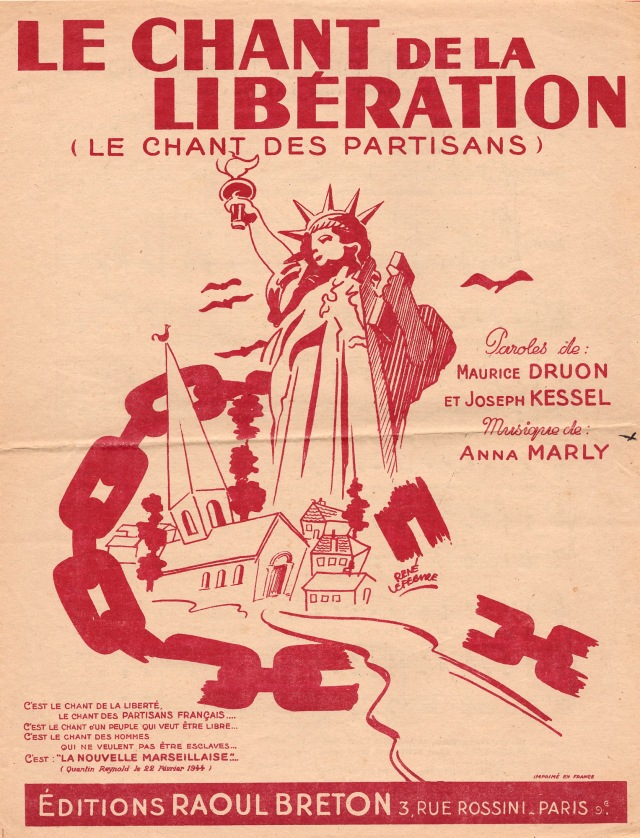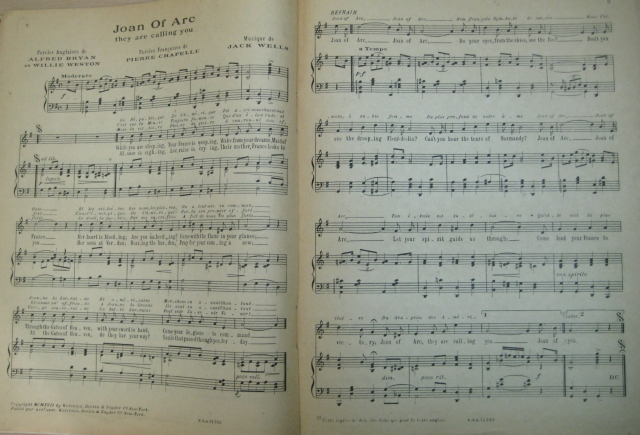The Chadwyck-Healey Liberation Collection (1944-46) consists mainly of books, but also contains a number of French and English songs and music scores, some with striking illustrations. They appear either in individual leaflets or in larger compilations, including the lyrics and in some cases notated music. On the 70th anniversary of VE Day (Victory in Europe), on 8 May 1945, we would like to shed light on two illustrated covers for songs of the Liberation that we displayed on the occasion of the 2019 Liberation lecture (Normandy ’44 by James Holland).
 Le chant de la libération : le chant des partisans, paroles de Maurice Druon et Joseph Kessel, musique de Anna Marly. Paris : Éditions Raoul Breton, 1945. Liberation.a.104
Le chant de la libération : le chant des partisans, paroles de Maurice Druon et Joseph Kessel, musique de Anna Marly. Paris : Éditions Raoul Breton, 1945. Liberation.a.104
The Chant des Partisans, presented as THE song of the liberation, was the most popular song of the Free French and French Resistance during World War II. It was the object of a recent exhibition, “Le Chant des partisans – création et diffusion” held at the Musée de l’Ordre de la Libération (October 2019 – January 2020), in partnership with the Musée de l’Armée, in Paris (see their additional resources). The song was composed in 1943 in London by the Franco-Russian singer and songwriter Anna Marly, after a popular Russian air. You can listen to the radio podcast of France Musique: “Anna Marly, la compositrice du Chant des partisans“. Her other wartime compositions include “La Complainte du partisan”, and “Une Chanson à trois temps”. In celebration of VE Day, the Institut Français has prepared a compilation of songs of liberation that resonated across France in and around 1945 (you can access it by login into Culturethèque).
The lyrics of the Chant des Partisans were translated into French by the writers Maurice Druon and his uncle Joseph Kessel, who both joined the resistant network Forces Françaises de l’Intérieur. At the time, the French anthem was banned, so the Chant des partisans quickly became a very popular replacement: “La nouvelle Marseillaise” (especially within the Résistance), according to the quote of the American journalist Quentin Reynold[s] featuring on the cover: “C’est le chant de la Liberté…”. In this publication by the Editions Raoul Breton, the illustration by René Lefébure combines realistic and symbolic elements. It shows, seen from below, the Statue of Liberty (both a reference to the American engagement in the liberation of France and a powerful emblem of Franco-American historical friendship) breaking through the chains encircling a French village and the standing if leaning church spire surmounted by a Gallic symbol, the weathercock.
 Ce que chantent les soldats américains : les 38 plus célèbres chansons d’Amérique pour piano et chant. The most famous tunes that Sammy sings. Paris : Éditions Salabert, 1945. Liberation.a.222
Ce que chantent les soldats américains : les 38 plus célèbres chansons d’Amérique pour piano et chant. The most famous tunes that Sammy sings. Paris : Éditions Salabert, 1945. Liberation.a.222
The second musical item we want to talk about is a collection of American songs, with parallel translation into French: The most famous tunes that Sammy sings. Sammy is the generic name given to the American soldier, the equivalent of Tommy for the British, a nickname which was widely spread during World War I. It probably derives from “Uncle Sam”, the personification of the United States, who notably featured on soldiers’ recruitment posters. On the red cover illustrated by Sara Ginst, five young American soldiers in khaki uniform sing a tune on a khaki jeep with an American flag.
Little is known about Sara Ginst, apart from the fact that she illustrated several music scores for Editions Salabert between 1943 and 1946, including Ceux du Maquis by Maurice Van Moppès, with music by Francis Chagrin (Liberation.b.666); La Madelon de la Victoire by Lucien Boyer, with music by Charles Borel-Clerc (Liberation.b.665), La Marseillaise (Liberation.a.336) or Hymnes des alliés, available both as “Grand album… pour piano et chant” (Liberation.a.337) and “Recueil pour violon et accordéon”.
All those songs feature among the advertisement pages for the Editions Salabert on the inside cover and last page of Ce que chantent les soldats américains: the titles are grouped into different sets, ranging from “Les chansons de la libération et de la victoire” (such as ‘Le chant des F.F.I.’, ‘Le grand Charles’, ‘All’s well mademoiselle’ or ‘Hello Sammy – Hello Tommy’) to the concert piece ‘Chant de libération’ for ‘voix solo, choeur à l’unisson et grand orchestre’, after a poem by the playwright and screenwriter Bernard Zimmer, with music by the composer Arthur Honegger, or the “Chants et récits patriotiques” (such as ‘La défense de Belfort’ or ‘Marche coloniale’).
What is interesting about the Sammy songs collection is that it does not focus on the most recent and trendy American music (such as the album “Fats Waller et le swing”, advertised in the compilation with a striking portrait), but rather on older, traditional American folk songs. Although American, the songs are not particularly military or war-related (though ‘Joan of Arc’, for example, was composed during World War I), but constitute ‘happy or tender songs evoking images of the native land, the family, the dear house –only images of peace’:
Un grand gars kaki est passé près de vous, en fredonnant un air qui vous est inconnu… et vous vous demandez, avec la curiosité et la sympathie dont vous entourez ce qui vient d’Amérique : ‘Qu’est-ce qu’il chante ?’. Cet album… groupe les plus fameuses et les plus jolies chansons que chantent les soldats américains… des chansons joyeuses ou tendres qui n’évoquent que des images de la terre natale, de la famille, de la chère maison –rien que des images de paix.
According to the preface, getting to know these famous songs is a way for the French to understand better the US soldiers: they act as a medium for cultural encounter, and contribute to the spirit of optimism of the Liberation. All songs are provided in English with parallel French translations, most by the songwriter Jean Cis, with a few by Pierre Chapelle and Lucien Boyer. Francis Salabert himself is often credited with the “harmonisation”.
In fact, apart from their title, the striking cover picture, the advertisements and the preface, the songs have very little to do with the Second World War. The publication could be considered as a skilful advertising stunt by the music publisher Salabert, who may have taken advantage of the arrival of the American soldiers to issue and sell a new edition of a stock of traditional American songs. A longer list of American songs published by Salabert, “les plus grands succès américains d’hier, d’aujourd’hui et de toujours”, including “jazz moderne”, features on the back cover.
Irène Fabry-Tehranchi






 Liberation.a.222
Liberation.a.222
Reblogged this on penwithlit and commented:
Brilliant material, fascinating.